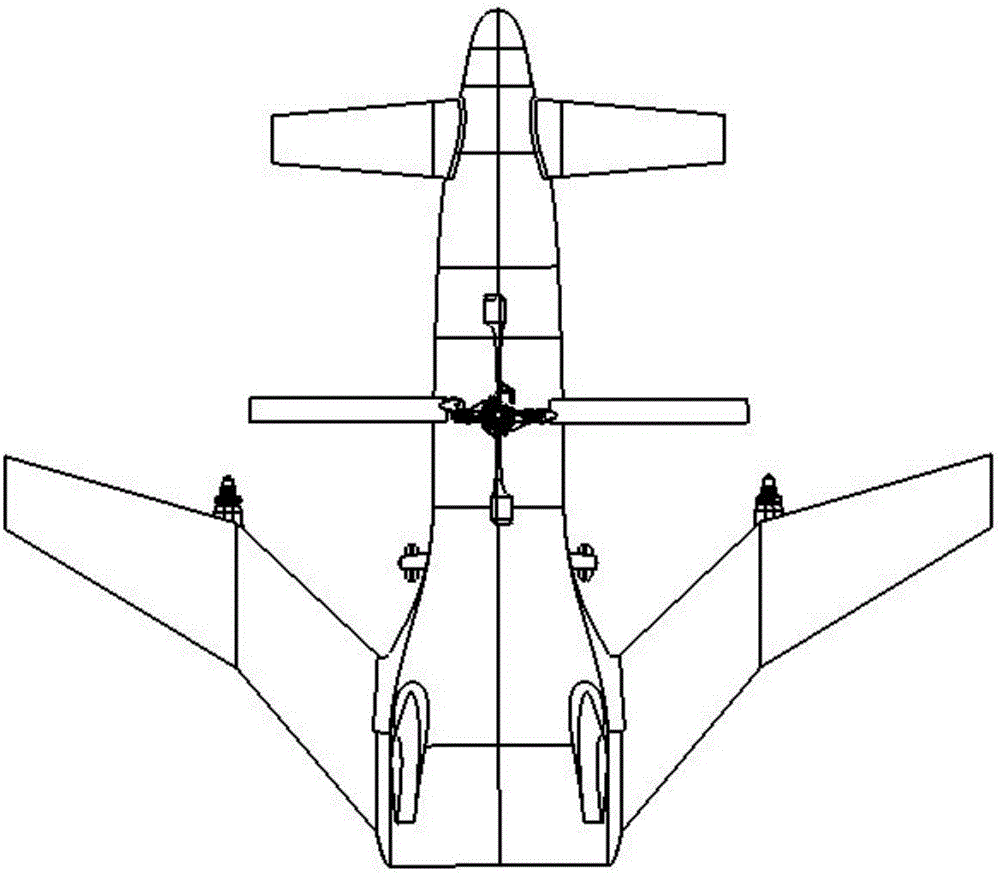Novel large-lift-force vertical take-off and landing aircraft
A technology for vertical take-off and landing and aircraft, which is used in vertical take-off and landing aircraft, aircraft, rotorcraft, etc. Insufficient maneuverability, reduction of adverse interference, reduction of bending torque
- Summary
- Abstract
- Description
- Claims
- Application Information
AI Technical Summary
Problems solved by technology
Method used
Image
Examples
Embodiment 1
[0031] Embodiments of the present invention provide a novel high-lift vertical take-off and landing aircraft, such as Figure 1~4 As shown, the aircraft includes: a fuselage 1, main wings arranged on both sides of the tail 4 of the fuselage 1, the main wings are formed by the conformal shape of the inner main wing 2 and the outer main wing 3, and the inner main wing 2 is a forward-swept wing, The forward sweep angle is 10°~75°, two vertical tails 5 are arranged above the tail 4 of the fuselage 1, canards 7 are arranged on both sides of the nose 6 of the fuselage 1, and the fuselage 1 A rotor 11 is arranged on the upper side, a power plant 12 is arranged between the inner main wing 2 and the outer main wing 3 , and a landing gear 15 is arranged at the bottom of the fuselage 1 . The rear and forward-swept settings of the inner main wing of the present invention prevent the wing from being in the downwash area of the rotor 11, thereby avoiding the adverse interference of the do...
Embodiment 2
[0035] Embodiments of the present invention provide a novel high-lift vertical take-off and landing aircraft, such as Figure 5 As shown, the aircraft includes: a fuselage 1, main wings arranged on both sides of the tail 4 of the fuselage 1, the main wings are formed by the conformal shape of the inner main wing 2 and the outer main wing 3, and the inner main wing 2 is a forward-swept wing, The forward sweep angle is 10°~75°, two vertical tails 5 are arranged above the tail 4 of the fuselage 1, canards 7 are arranged on both sides of the nose 6 of the fuselage 1, and the fuselage 1 A rotor 11 is arranged on the upper side, a power plant 12 is arranged between the inner main wing 2 and the outer main wing 3 , and a landing gear 15 is arranged at the bottom of the fuselage 1 . The rear and forward-swept settings of the inner main wing of the present invention prevent the wing from being in the downwash area of the rotor 11, thereby avoiding the adverse interference of the down...
Embodiment 3
[0040] Embodiments of the present invention provide a novel high-lift vertical take-off and landing aircraft, such as Image 6 As shown, the aircraft includes: a fuselage 1, main wings arranged on both sides of the tail 4 of the fuselage 1, the main wings are formed by the conformal shape of the inner main wing 2 and the outer main wing 3, and the inner main wing 2 is a forward-swept wing, The forward sweep angle is 10°~75°, two vertical tails 5 are arranged above the tail 4 of the fuselage 1, canards 7 are arranged on both sides of the nose 6 of the fuselage 1, and the fuselage 1 A rotor 11 is arranged on the upper side, a power plant 12 is arranged between the inner main wing 2 and the outer main wing 3 , and a landing gear 15 is arranged at the bottom of the fuselage 1 . The rear and forward-swept settings of the inner main wing of the present invention prevent the wing from being in the downwash area of the rotor 11, thereby avoiding the adverse interference of the downw...
PUM
 Login to View More
Login to View More Abstract
Description
Claims
Application Information
 Login to View More
Login to View More - R&D
- Intellectual Property
- Life Sciences
- Materials
- Tech Scout
- Unparalleled Data Quality
- Higher Quality Content
- 60% Fewer Hallucinations
Browse by: Latest US Patents, China's latest patents, Technical Efficacy Thesaurus, Application Domain, Technology Topic, Popular Technical Reports.
© 2025 PatSnap. All rights reserved.Legal|Privacy policy|Modern Slavery Act Transparency Statement|Sitemap|About US| Contact US: help@patsnap.com



